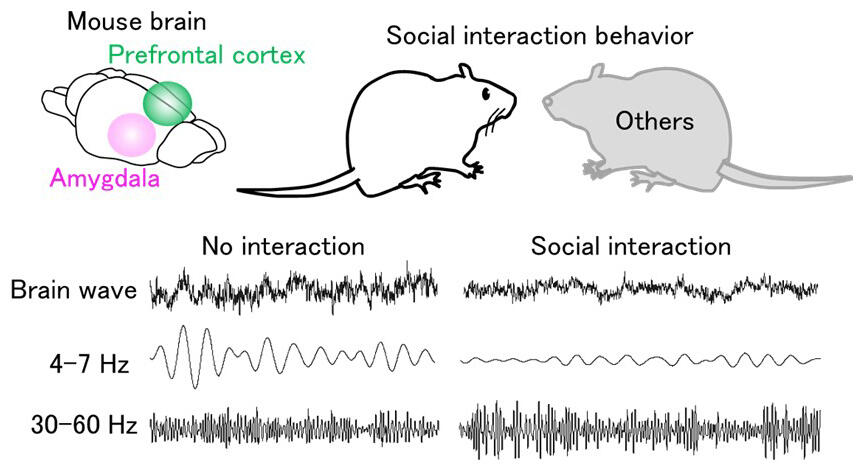Professor Takuya Sasaki and researcher Nahoko Kuga of the Graduate School of Pharmaceutical Sciences, Tohoku University, Professor Yuji Ikegaya of the Graduate School of Pharmaceutical Sciences, The University of Tokyo, and their colleagues have discovered a pattern of brainwaves generated by the frontal cortex and amygdala when sociality is exhibited through experiments using mice. Professor Sasaki noted, "As brainwaves can be measured during everyday life, unlike with MRI scans, we believe that they will be a key indicator for reading a variety of mental states in the future." The group's results were published online in eLife.

Provided by Tohoku University
To animals, social behavior as part of their interaction with others is an important function. Sociality is a complex attribute that is determined by a combination of different factors, including an individual animal's developmental process and experiences to date, their on-the-spot emotions and their state of mind, e.g. feelings of anxiety, but very little has been clarified when it comes to the relevant mechanisms of the brain.
From many past studies, researchers already know that the parts of the brain known as the prefrontal cortex and amygdala are important to emotion and anxiety, which are elements of sociality. From this background, the research group carefully investigated the connection between social behavior and nervous activity, with a focus on these parts of the brain.
Mice, like people, show a variety of social behaviors (touch and sympathy) towards others. At the start of the experiment, metal electrodes were implanted in the prefrontal cortices and amygdalae of the mice, and the group measured their brainwaves (the electric signals generated by these parts of the brain). Brainwaves are generated from the collective activity of countless cranial nerve cells and are formed from electromagnetic waves with a variety of frequency bands. Delta waves (1-4 hertz) are associated with sleep and waking up, theta waves (4-7 hertz) with memory and anxiety, beta waves (10-20 hertz) with exercise and cognition, and gamma waves (30-100 hertz) with caution and concentration in the brain. People and mice have many characteristics in common.
The time target mice spent on social interaction with others was detected using video. When their brainwaves were analyzed, it was found that theta waves had reduced in the prefrontal cortex and amygdala, but beta waves had increased. "Many past experiments measured brainwaves as a whole and did not isolate the periods when the mice engaged in social behavior. I think that's why they couldn't see this change." (Professor Sasaki) Next, the researchers put the mice under chronic stress to create mice that showed depression-like symptoms. They also created genetically modified mice that showed symptoms of autism-spectrum disorders. These mice exhibited very little social interaction, and during this time the researchers rarely observed the brainwave pattern discovered in this experiment.
Thus, the group developed a new genetic modification technique/optical manipulation technique tailored to these brainwaves to artificially manipulate their strength. When this technique was applied to the mice with reduced sociality and their brainwave patterns returned to the same level as normal mice, their social behavior was restored.
These research outcomes suggest that this new prefrontal cortex and amygdala brainwave pattern acts as a brain mechanism for social behavior. In the future, it is hoped that fluctuations in these brainwaves will help to treat illnesses that exhibit reduced sociality.
Journal Information
Publication: eLife
Title: Prefrontal-amygdalar oscillations related to social behavior in mice
DOI: 10.7554/eLife.78428
This article has been translated by JST with permission from The Science News Ltd.(https://sci-news.co.jp/). Unauthorized reproduction of the article and photographs is prohibited.




